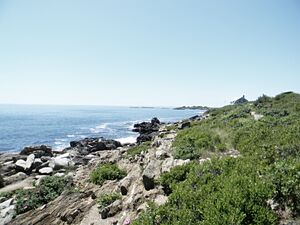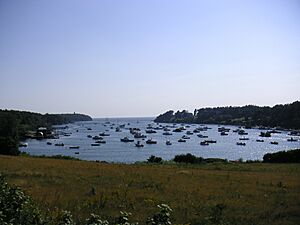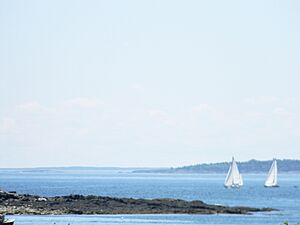Bailey Island (Maine) facts for kids

Bailey Island is a beautiful island located in Casco Bay, which is part of the town of Harpswell in Cumberland County, Maine, United States. In 2000, about 400 people lived on the island all year round. It's a popular spot for visitors, especially in the summer!
Contents
Island History and Name
Bailey Island was first called Newaggin by the local Abenaki Native Americans. European settlers started living there in the 1600s.
The first European settler was William Black, whose father was a freed slave. William Black sold land he inherited and moved to what became Bailey Island. Because he lived there, the island was first known as Will's Island.
A story says that in 1742, Reverend Timothy Bailey might have bought Will's Island from William Black for some tobacco and rum. Another version of the story suggests that the Baileys really liked the island. They might have found a way to get the island's ownership transferred to them. After Timothy Bailey and his wife took over, William Black moved to Orr's Island. From then on, the island became known as Bailey Island.
In 2020, a very rare event happened near Bailey Island. A swimmer was sadly injured by a great white shark, which was the only recorded shark attack in Maine's history.
The Unique Bailey Island Bridge
The Bailey Island Bridge connects Bailey Island to Orr's Island. It crosses a narrow channel called Will's Gut. The bridge was finished in 1928. Will's Gut is the only place that still has the name of William Black, the island's first non-native resident.
This bridge is super special because it's the only "cribstone" bridge in the world! It's built using rocks, sand, and gravel. People used to think there was another one in Scotland, but no one has ever found proof of it. The cribstone design is clever because it lets the strong ocean tides flow freely through the bridge. This helps boats move easily through the narrow channel. The island is also known for a statewide football game held there every year.
Famous People Who Loved Bailey Island
Many interesting people have spent their summers on Bailey Island.
Three important female psychoanalysts, Esther Harding, Eleanor Bertine, and Kristine Mann, were followers of Carl Jung. They spent many summers here. Kristine Mann was even studied by Jung himself! Carl Jung, a very famous thinker, also visited Bailey Island and gave talks at the Bailey Island Library Hall. Kristine Mann's sister, Anna Mann Richardson, also studied with Jung and enjoyed summers on the island.
The artist Ida Waugh and writer Amy Ella Blanchard were lifelong friends. They owned summer cottages next to each other on the island. Together, they helped start a summer chapel for the Episcopal church, which was completed in 1916.
Frank Aydelotte, who was the president of Swarthmore College, also spent his summers on Bailey Island. He met Holbrook Mann MacNeille and Stephan Mann MacNeille here in the 1920s. These two were nephews of Kristine Mann and Anna Mann Richardson. With Aydelotte's encouragement, both went to Swarthmore and later became successful in physics and mathematics.
Another famous summer resident was George Frederick Root. He was a composer during the American Civil War. He sadly passed away on the island in 1895.
Cool Places to See on Bailey Island
Bailey Island has many cool spots to explore:
- The Bailey Island Bridge, the world's only cribstone bridge.
- Mackerel Cove, a beautiful spot where you can see lobster boats. It's one of the most photographed places in Maine!
- Land's End, a famous rocky beach at the very end of the island.
- The Maine Lobsterman, a bronze statue that was first made for the 1939 World's Fair.
- The Giant Stairs (also called "The Giant's Steps"), a rock formation that looks like a huge staircase leading down to the ocean.
- "The Nubble", a small bait shack that is often photographed. This is where local lobstermen keep their buoys.
- Two old fire control towers from World War II, located near the southern tip of the island.




